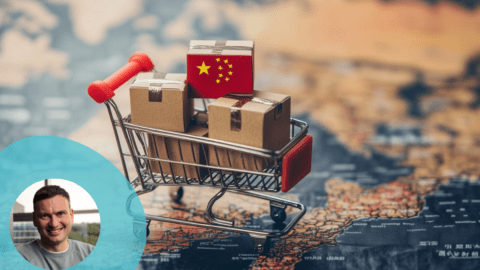Following is Part 2 of the Retail TouchPoints series, titled: Advances In Cross-Border Trade. This section reviews the next steps in pursuing global commerce. Part 1, which offered retailer success statistics, and guidance on assessing readiness and determining market entry points, appeared in the June 4 newsletter.
The unclaimed consumer demand pulsing in numerous international markets has e-Commerce, omnichannel and brick-and-mortar retailers motivated to assess their readiness for global expansion. These merchants are evaluating corporate goals, capabilities, resources, potential market challenges and whether to grow with physical stores, e-Commerce-only or multichannel development.
Retailers who have passed the readiness assessment test and identified their market entry points are eager to embark on the next steps to global expansion. Two of the key steps a retailer must address when considering cross-border trade include: utilizing the most appropriate form of entry; and conquering the challenges of global shipping, languages, currencies and other market requirements.
Popular Forms Of Entry
A move into new overseas markets can take several forms, according to The Accenture Global Index, February 2013. These approaches include:
- Opening a new format in a new country;
- Opening a new country-specific web site;
- Acquiring a company in a target market;
- Creating a joint venture in a target country; and
- Launching a franchise operation in a target country.
During the last half of 2012, according to Accenture, web site launches ― in addition to organic growth ― accounted for nearly two thirds of all market entries: “Web sites are now equal to franchise expansion as a way to enter a market.”
But historically, retailers have leaned toward the franchise model for growing their businesses in developing markets, noted a white paper from Javelin Group, titled: International Retail: New Channels And New Frontiers. The benefit of this approach is to reduce the financial risk of expanding internationally. However, “clearly this represents a potential barrier to developing a multichannel approach,” the Javelin study indicated. Franchisees fear the expanding reach of franchisor partners’ e-Commerce channels, concerned that they will “divert sales directly back to headquarters at the expense of the store network these franchisees have developed locally. To address these issues, some notable international master franchisee operators are now developing their own e-Commerce skills, opening up multichannel opportunities for those western retailers choosing to expand via franchise.”
The Amazon Form Factor
Online markets are excellent avenues for seizing demand quickly and in the near term across global markets. For example, Amazon operates third-party marketplaces in Canada, China, France, Germany, Italy, Japan, Spain, the UK and the U.S. The digital commerce company recently reported some “impressive statistics” concerning these markets, stated Gina DeFrank, Marketplaces Business Analysts for ChannelAdvisor.
DeFrank stated that:
- Amazon’s European marketplaces had more than 164 million active customers last year;
- 30% of total Amazon units are sold by third-party sellers; and
- Amazon.co.uk receives about 20 million unique visitors monthly, Amazon.de has 24 million and Amazon.fr has 13 million.
Retailers can “dip their toes” into international waters by receiving orders from buyers outside of the U.S., said DeFrank. The next logical move is to start listing inventory on the Amazon UK marketplace, since listings are in English, she stated, then eventually expand to other European marketplaces such as those in France, Germany and Italy.
In order to make these moves successfully, retailers can consider a program called Amazon FBA Export, which assists U.S. sellers with fulfillment. (FBA stands for Fulfillment By Amazon.) “When retailers enroll in this program,” DeFrank explained, “all of their qualifying product listings are eligible for international orders on Amazon.com at no extra charge.”
U.S. retailers that create an account to list products on Amazon.co.uk also can use Amazon FBA Export by sending products to a UK FBA location. The program allows buyers located in other EU countries to purchase from U.S. sellers. “For example, a consumer in France is able to buy a U.S. retailer’s product listed on Amazon.co.uk and have it fulfilled through FBA from the UK,” said DeFrank. “Today, there are no extra fees for using this program and the European FBA Export program supports a much wider list of products.”
Shipping Made Easier With eBay GSP
The selling process is the first step in a successful global commerce strategy, but retailers also must address shipping and delivery issues. Consumers in all countries expect timely delivery of purchased goods through shipping processes that avoid delays due to customs, duties, taxes and country-specific shipping regulations.
To address cross-border shipping challenges, eBay introduced a new solution in Q3 2012 designed to make it simpler for U.S.-based retailers to ship goods to international buyers and efficiently manage customs issues. The eBay Global Shipping Program (GSP) “streamlines international selling by automatically including all shipping forms, declarations and customs charges in the buyer’s purchase price,” said DeFrank, “and by reducing retailers’ efforts to a simple domestic shipment at no additional charge.” GSP participants simply forward packages to a U.S. address where full automation of the international shipping process takes place.
“Using GSP provides easier access to the millions of additional buyers in the 18 international countries eBay currently supports,” said DeFrank, “and those coming in the future.”
In one example, Austin Bazaar generated “$100,000 in GSP sales in our first month,” stated Jason Birchmeier, Operations Manager for the musical instrument and accessories retailer. “I especially like that we don’t have to worry about customs, duties, and similar international shipping issues.”
The next pain point for Austin Bazaar and many other retailers is cross-border returns and exchanges. “As a cross-border seller, you may find, as we did, that it’s more cost-effective to offer a partial refund than to reship,” said Birchmeier. “Our warehouse handles the GSP orders separately to certify complete accuracy, because when you sell internationally, you only get one chance to get the order right.”
Global Trade Management Solutions Increase Visibility
Just as the eBay GSP eases the shipping process, Global Trade Management (GTM) solutions — such as those from Amber Road, Oracle Retail and other providers — offer automated and integrated platforms that help retailers manage most aspects of international trade operations.
The GTM product from Amber Road is a single repository for all global trade compliance and logistics information. “The scalable technology improves customer service levels, and allows retailers to respond faster to ― and demonstrate ‘reasonable care’ with ― customs and internal audits,” said Hung Lee, Product Manager for Amber Road. “The platform also serves as a foundation for additional value adds such as self-filing and leveraging free trade agreements. In addition, it decreases compliance risk by reducing errors, and improves restricted party screening.”
The Oracle GTM solution is designed to help companies optimize and streamline cross-border trade business processes by layering trade data and milestones over the physical flow of goods. The offering helps retailers implement and enforce their well-structured internal compliance policies, with the goal of achieving best trade practices across their global expansion enterprises.
Local Languages And Currencies
To be successful abroad, global trade solutions must accommodate local languages and currencies. For example, Oracle Retail solutions support 18 languages as standard, with new languages added regularly. In addition, the Oracle platform supports retailers that operate in several countries with multiple sets of financial books, and automatically translates pricing into multiple local currencies.
Not surprisingly, the majority of international consumers strongly prefer viewing prices that correspond to their local currency, according to research conducted by Penton Research and commissioned by EX4, titled: Local Currency Pricing For E-Commerce. The study polled 30,000 online shoppers in Australia, Canada, Germany and the UK concerning their e-Commerce shopping habits. A vast majority (92.2%) of respondents said they prefer to shop and make purchases on web sites that price products in local terms. One third also showed an aversion for USD-only pricing by either abandoning carts, purchasing less, leaving the site to check conversion rates, or never returning to the site.
“USD-only web sites are leaving money on the table by ignoring global shopper preferences,” said Gary McDonald, President of EX4. “Many e-Commerce merchants don’t realize that they can price in foreign currencies and still settle in an expected, guaranteed amount of USD.”
Moreover, most respondents to the currency survey said they either “definitely” or “probably” would spend more money with an online merchant who offers prices in their local currencies, including 71% of respondents from the UK, 59% from Australia, 53% from Canada, and 35% from Germany.
In addition to ChannelAdvisor, EX4, Oracle Retail and other providers in the global e-Commerce space, NetSuite also helps retailers cross borders with multi-functional commerce platforms that address international trade. Among the features, the cloud-based NetSuite e-Commerce solution supports more than 190 currencies; multiple brands and devices; taxation compliance for more than 40 countries; optimized invoicing, payments and purchasing; and more.
Williams-Sonoma, Inc., which markets home goods under the Williams-Sonoma, Pottery Barn, Pottery Barn Kids and West Elm brands, recently announced that the NetSuite SuiteCommerce multichannel retail and business management platform will support the retailer’s global expansion into Australia. The technology is powering four newly launched and individually branded e-Commerce storefronts. The stores and web sites for each brand were launched simultaneously in May 2013.
Williams-Sonoma, Inc., also implemented NetSuite solutions to reduce infrastructure investments and deployment risk; and manage procurement, order and inventory management, order reconciliation, financial reporting and other tasks. In addition, the retailer selected NetSuite solutions for international commercial freight logistics and customs operations management, international subsidiary management and global financial consolidation.
From a functionality standpoint and technology perspective, NetSuite “enables us to handle the complexity of global multi-channel commerce,” said John Strain, Williams-Sonoma CIO.
NetSuite also supports 19 global languages. As retailers such as Williams-Sonoma, Inc., consider expansion into non-English-speaking countries, “it’s important to leverage commerce platforms that support several languages so that global development plans can be realized in a multitude of markets,” said Baruch Goldwasser, Director of Commerce for NetSuite, in an interview with RetailTouchPoints. “For example, when retailers sell into China, can they also offer spoken or written answers to questions asked in Chinese? Without the proper language skills to sell as well as support their products, retailers are compromising their customer service objectives.”
Cross-border retailers also benefit by utilizing “a cloud-based platform that can be managed from home base,” added Goldwasser, “while also providing centralized, real-time visibility into business functions around the world.”
Advanced technologies from a plethora of leading solutions providers ― not withstanding those in payments, supply chain management, language translations, fraud prevention and related global commerce spaces ― can help make a retailer’s transition to cross-border trade easier and more productive. In fact, with increasing retailer demand for technologies and solutions that support global expansion, several providers have formed, and continue to join, the new Global Retail Insights Network. Announced June 5, 2013, GRIN is “an integrated coalition of companies seeking to reduce the complexity for retailers wanting to rapidly expand beyond domestic borders into global markets,” according to the press release. “These companies all bring specific expertise on advising companies on international expansion and offer many of the technology and services required to do so. Other organizations will be added in the future based on retailer needs.”
Evolutionary, Not Revolutionary
Even with increasing industry focus, global expansion is evolutionary, not revolutionary, and won’t happen overnight: The move requires a significant time and resource commitment to be successful in the long term, noted a Deloitte industry report, titled: Retail Global Expansion: The Journey Starts At Home.
“Retailers that are taking strategic actions now will be in a stronger position to grow,” the report indicated. Retailers that merely “think” about taking action today likely will be challenged by playing catch-up with the leaders of tomorrow.
To access a PDF of this complete 2-part series, click here.












